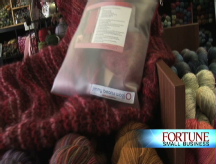Small biz: Turn an idea into a fortune
Answers to key questions about bringing a brainstorm to market, how to protect it and what to charge your customers
(Money Magazine) -- Question: What can I do to protect my novel service or product idea when I'm presenting it to a large business? - Sam Klaidman, Framingham, Mass.
Answer: You're right to be cautious. Earlier this year a woman sued Victoria's Secret, claiming the retailer had rejected an innovative bra she'd pitched - it could be worn 100 ways! - only to later mass-produce it. (The company declined to comment.)
While the cases aren't always so salacious, allegations of stolen intellectual property are, unfortunately, common. "I've seen too many cases where small business owners turn to large companies for help, then lose it all," says attorney Ian Stock of EntrepreLaw in Silicon Valley.
Still, the benefits of securing a partnership with a bigger corporation (the firm can help you refine, expand and market the idea) often outweigh the potential drawbacks. Just be sure to put some legal safeguards in place before the pitch.
Start by creating an inventor's notebook that details how you developed the idea, says Louis Foreman, executive producer of Everyday Edisons on PBS and holder of nine patents. Have someone with no stake sign each page to certify that he or she understands your process.
This documents your invention's timeline. If there's ever a legal dispute, U.S. law accords ownership to the first person to come up with the idea, not the first to nab a patent.
Next, work with an attorney to secure a patent, full or provisional. Provisional patents act as temporary placeholders - they give you one year to investigate the invention's feasibility.
Also have your lawyer write a nondisclosure agreement. "This simple contract protects the confidentiality of each side's intellectual property," Stock says. "It states that you won't use any information you learn about the other party unless you do business together." Ask the firm you're pitching to sign it before you meet.
Finally, at the presentation, share some of your idea, not all of it. Says Stock: "The firm should understand that you want to establish trust first." - Emily Maltby
Question: I have some potentially profitable new product ideas. How do I get a manufacturer interested? - Alan Moreno, Boynton Beach, Fla.
Answer: The good news is that consumer demand for new products is outstripping the ability of large companies to come up with marketable ideas.
"There was a time when companies invented everything in-house," says inventor Louis Foreman. "But that was when products had a shelf life of five to 10 years. Now a lot of the revenue at large consumer companies comes from products less than two years old."
As a direct result of this increased demand, manufacturers and distributors are increasingly opening their doors to outside inventions. With the right approach, yours could be next.
Your first step is to create what's known as a sell sheet, says Stephen Key, co-founder of InventRight, an entrepreneurial education firm in San Francisco. This is a one-page description of your product that outlines its benefits, your target audience and its projected profits (make sure your name and contact info are also on the sheet).
The idea is that busy marketing execs, who might not have the time or inclination to read a long pitch, will be able to see your product's potential at a glance. Don't worry about creating a prototype at this point, adds Key; an interested manufacturer will likely want to produce its own sample.
Once your sell sheet is ready, develop a list of manufacturers that target your ideal customer and make similar products. Get the number for corporate headquarters via each one's Web site, then ask for the director of marketing or sales.
"Say you're a product developer with a great idea," Key advises. "I never use the word inventor because people have strange ideas about inventors."
You'll likely have only a few seconds to make your pitch, so pique the executive's interest by concisely stating the idea, the profit potential, comparative advantages and a timeline for results. Offer to send a sell sheet. Then be persistent (but not a pest) about following up. - Alison W
Question: I run a retail business. How do I determine what to charge for the products I sell? - Linda Diaz, San Juan Capistrano, Calif.
Answer: Figuring out the right price for your goods and services is the key to keeping your books in the black. Unfortunately, there's no simple formula for pricing.
The most common mistake? "Companies often underprice the market for their product," says Brooks Fenno of Sales Mark, a Boston consulting firm for small and mid-size businesses. "If you're not careful, you can very quickly steer your company into insolvency."
The basic math on markup starts with how much the product costs you - from labor and raw materials to fuel for delivery trucks.
"Companies that produce comparative products have different overheads and infrastructures that cause the price relations to be different," says Kevin Clark of Clark Marketing Group in Draper, Utah. "If you charge $5 because everyone else does but it costs you $4.95 to make the product, you're left very little margin."
Thus begin with your own break-even price and build from there. The sweet spot above cost depends on a number of factors, including the area in which you do business, the competition you face and the state of the economy.
Getting to know your market well can help you narrow down a perfect price. It's crucial to find out what your competitors are charging, the quality of their merchandise and what extra services or features they include, advises Laura E. Willett, a longtime adviser to small business owners and a senior finance lecturer at Bentley College in Waltham, Mass.
Then put your products into context based on those factors. "Pricing is about what customers are willing to pay and the perceived quality of the goods," Willett adds. "Customers will usually be willing to pay more if you can convince them you have a better product."
The next step, then, is to home in on the features that make your product or service special and determine how much of a premium your target audience would pay for them.
The best way to figure out the answers, says Clark, is to conduct focus groups and surveys with your ideal customers: Let them tell you how much they're willing to pay for your products. - Paul F. Roberts
Need help with your business? Your Shop is written by the editors of Money Magazine's sister publication, Fortune Small Business. Submit your questions to FSB's experts and to other small business owners at cnnmoney.com/askfsb.
- Hibah Yousuf contributed to this article. ![]()



